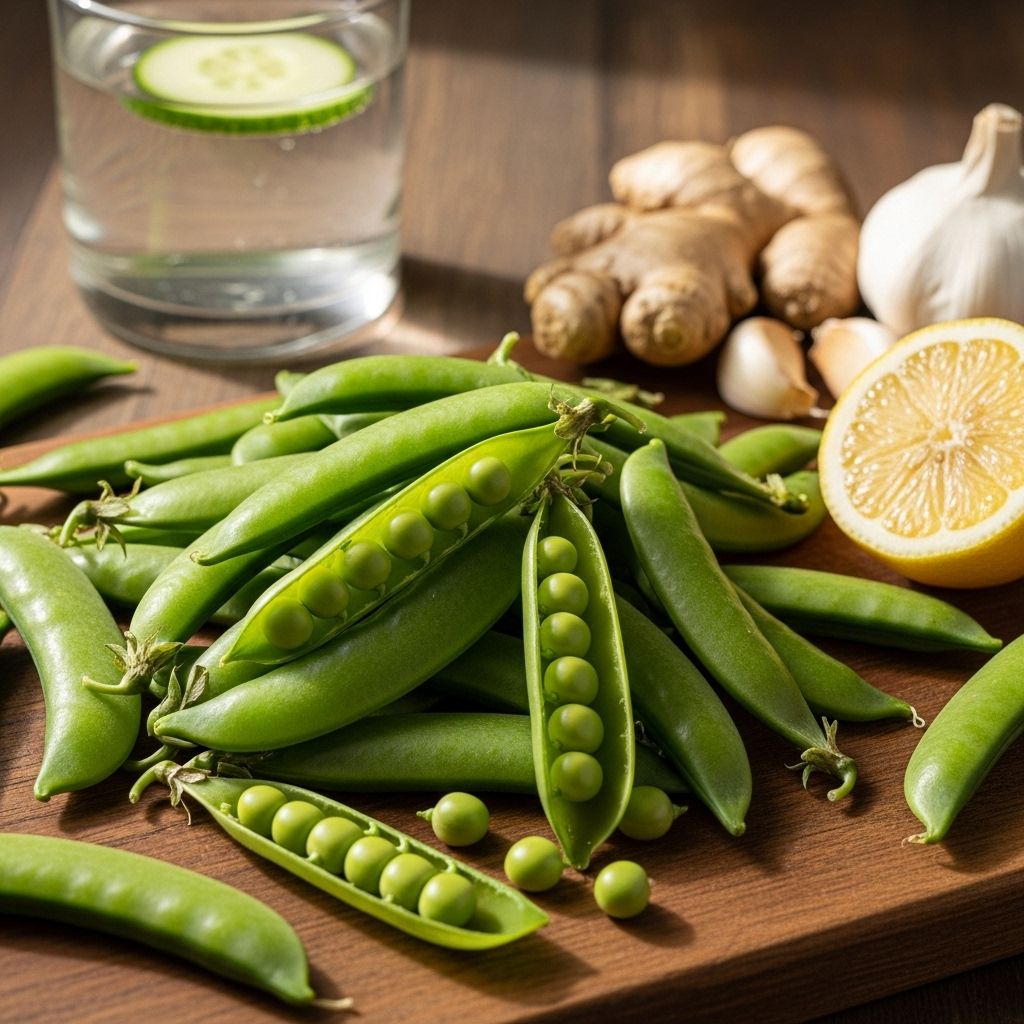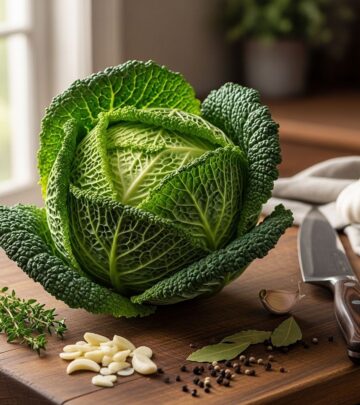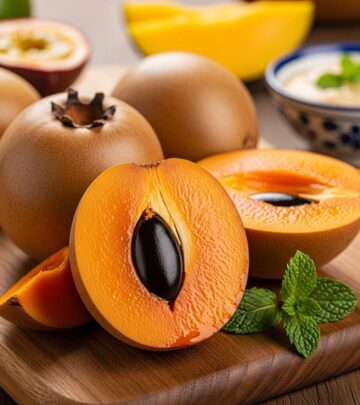13 Proven Health Benefits of Sugar Snap Peas
A crunchy, nutrient-rich snack that nourishes your body from the inside out.

Sugar snap peas—those crisp, sweet, edible-pod legumes—are not just a delicious crunchy snack but a nutrition powerhouse rich in vitamins, minerals, and health-boosting antioxidants. Celebrated for their versatility in the kitchen, sugar snap peas offer a range of science-backed advantages that support immunity, digestion, heart, bone health, and overall vitality. This comprehensive guide explores their nutritional composition, major health benefits, and practical culinary uses.
What Are Sugar Snap Peas?
Sugar snap peas (Pisum sativum var. macrocarpon) are a hybrid legume, combining the tenderness of snow peas with the sweetness of garden peas. Unlike many other peas, both the pod and the seeds are edible, offering a uniquely crunchy, mildly sweet flavor profile that makes them popular in salads, stir-fries, snacks, and more. They belong to the broader legume family, which includes chickpeas, lentils, and green peas, each known for nutrient density and numerous health benefits.
Nutritional Profile of Sugar Snap Peas
| Nutrient (per 100g) | Amount |
|---|---|
| Calories | 35–67 kcal |
| Protein | 2.8–5.2 g |
| Carbohydrates | 7–11.3 g |
| Dietary Fiber | 2.8–4.5 g |
| Sugar | 6.4 g |
| Fat | 0.4 g |
| Vitamin C | 100% DV* |
| Vitamin K | Delivered in notable quantities |
| Vitamins A, B6, B1, B2, Folate (B9) | Notable amounts |
| Minerals | Iron, Magnesium, Manganese, Potassium, Calcium, Copper, Zinc |
*DV: Daily Value. Actual figures vary slightly by source.
Top Health Benefits of Sugar Snap Peas
1. Immune System Support
Sugar snap peas are a rich source of vitamin C, providing up to 100% of the daily recommended intake in just 100 grams. Vitamin C is crucial for the production and activation of white blood cells, helping defend against infections and supporting faster healing. Alongside vitamin C, beta carotene (precursor to vitamin A) found in snap peas contributes to proper immune cell function and vision health.
2. Cardiovascular Health
Sugar snap peas support heart health thanks to their content of fiber, antioxidants (vitamin C and flavonoids), and potassium. Soluble fiber helps lower LDL cholesterol and triglycerides, while potassium assists in regulating blood pressure by balancing sodium.
- Reduce cholesterol and triglycerides with soluble fiber.
- Nitrates in peas may help improve blood flow and lower blood pressure.
- Vitamin K aids in preventing calcification of blood vessels, further supporting heart health.
3. Digestive Health
Sugar snap peas deliver 2.8–4.5 grams of fiber per 100 grams, most of which is insoluble fiber. This promotes regular bowel movements, supports a healthy gut microbiome, and prevents constipation.
- Fiber serves as prebiotics, nourishing beneficial gut bacteria.
- A healthy gut flora is linked to better digestion, immune function, and reduced risk of digestive disorders.
4. Bone Strength and Health
Vitamin K is essential for bone mineralization and density. Sugar snap peas offer substantial vitamin K, helping to direct calcium into your bones and reduce the risk of osteoporosis and fractures.
- Supports healthy blood clotting, crucial for injury recovery.
- Deficiencies in vitamin K are associated with lower bone density.
5. Weight Management and Satiety
Sugar snap peas are low in calories and high in fiber and water, making them ideal for weight management. They promote fullness, reduce overall calorie intake, and can help satisfy cravings in a healthy way.
- Perfect for snacking due to their crunch and sweet flavor.
- Can be eaten raw, steamed, or added to meals for extra bulk without excessive calories.
6. Blood Clotting
Thanks to high vitamin K content, sugar snap peas support proper blood clotting, reducing excessive bleeding risks from wounds and aiding bodily healing.
7. Blood Pressure Regulation
Potassium and magnesium in snap peas help regulate blood pressure by counteracting sodium’s effects, relaxing blood vessels, and supporting heart function.
8. Antioxidant Benefits
Vitamin C, vitamin E, beta carotene, carotenoids, and flavonoids help neutralize harmful free radicals, reducing cell damage and potentially lowering cancer and heart disease risks.
9. Energy and Metabolism
B vitamins (B1, B2, B6, pantothenic acid, and folate) in sugar snap peas promote efficient energy production from food and support nerve function and red blood cell formation.
- Vitamin B6 helps metabolize proteins.
- Folate is essential during pregnancy for cell growth and fetal development.
10. Eye and Skin Health
Vitamin A (in the form of beta carotene) in snap peas supports good vision and maintains healthy skin. Beta carotene may help delay age-related eye disorders.
11. Diabetes and Blood Sugar Control
Low glycemic index and dietary fiber in snap peas help stabilize blood sugar levels and slow glucose absorption, making them suitable for people managing blood sugar.
12. Muscle and Nerve Function
Minerals like magnesium and potassium are important for muscle contraction, nerve signal transmission, and overall cardiovascular health.
13. Pregnancy and Fetal Development
Folate (vitamin B9) is crucial before and during pregnancy to prevent neural tube defects in babies. Just one cup of sugar snap peas provides a valuable amount of this essential nutrient.
How to Incorporate Sugar Snap Peas Into Your Diet
The natural sweetness and crunch of sugar snap peas make them an easy addition to countless dishes. Their edible pods remove the need for shelling or peeling, and they require minimal preparation. Here are some popular and nutritious ways to use them:
- Raw: Enjoy as a snack or add to vegetable platters with a healthy dip.
- Salads: Halve or chop peas and toss into green salads for extra crunch.
- Stir-fries: Quick-cook with other vegetables, meats, or tofu for a crisp bite.
- Roasted: Toss peas with olive oil and seasonings, roast until tender.
- Soups and Stews: Add during the last minutes of cooking to preserve texture.
- Kids’ Lunches: Their natural sweetness makes peas a child-friendly finger food.
Tips for Selecting and Storing Sugar Snap Peas
- Look for bright green, firm pods with a smooth surface and no spots or dryness.
- Store unwashed peas in a resealable bag in the fridge for up to a week.
- Wash just before eating to preserve crispness.
- For longer storage, blanch and freeze peas.
Potential Drawbacks and Considerations
- Allergies: Some individuals with legume allergies (such as to peanuts or soy) may react to sugar snap peas, though this is rare.
- FODMAPs: Peas are a moderate source of FODMAPs, which may cause bloating or digestive discomfort in people sensitive to these compounds. Introduce gradually and monitor symptoms if you have IBS or similar conditions.
- Pesticides: Snap peas are relatively low in pesticides compared to some other produce but wash thoroughly or choose organic to minimize risk.
Comparing Sugar Snap Peas and Snow Peas
| Property | Sugar Snap Peas | Snow Peas |
|---|---|---|
| Pod Thickness | Plump, round | Flat, thin |
| Texture | Crisp and juicy | Delicate, less juicy |
| Flavor | Sweet and mild | Mild, less sweet |
| Edible Pod? | Yes | Yes |
| Best Uses | Snacking, stir-fries, salads | Stir-fries, steamed dishes |
| Main Nutrients | Vitamin C, K, fiber | Vitamin C, K, fiber |
Frequently Asked Questions (FAQs)
Q: Are sugar snap peas the same as snow peas?
A: No, sugar snap peas are a hybrid between garden peas and snow peas. They have a plumper, sweeter pod compared to the flatter, more delicate snow pea pods.
Q: Can I eat sugar snap peas raw?
A: Yes, sugar snap peas are excellent raw. Their crisp texture and sweet taste make them ideal for snacking, salads, and lunchboxes.
Q: Are sugar snap peas high in sugar?
A: Despite the name, sugar snap peas contain only a moderate amount of natural sugars. They are low in calories and have a low glycemic load, making them suitable for most diets.
Q: How do I prepare sugar snap peas for cooking?
A: Wash peas thoroughly and, if desired, trim the ends and remove any strings that may run along the seam of the pod. They cook quickly—just a few minutes of steaming, sautéing, or stir-frying is sufficient to retain their texture and nutrients.
Q: Are sugar snap peas safe for people with diabetes?
A: Yes, sugar snap peas have a low glycemic index, are rich in fiber, and are relatively low in carbohydrates, making them a good vegetable option for people managing blood sugar.
Q: Can children and toddlers eat sugar snap peas?
A: Yes, sugar snap peas are safe for children when served in age-appropriate sizes (e.g., sliced for toddlers to prevent choking). Their natural sweetness often appeals to young palates.
Conclusion
Sugar snap peas are a remarkable addition to a healthy diet, offering a spectrum of vitamins, minerals, and fiber with very few calories. Regular inclusion in meals can support immunity, weight and blood sugar management, bone and heart health, and more. Their convenience and versatile flavor make them a staple for families and health enthusiasts alike.
References
- https://www.healthline.com/nutrition/snow-peas-vs-sugar-snap-peas
- https://www.youtube.com/watch?v=NIWOxIcwt28
- https://www.healthyfood.com/healthy-shopping/the-health-benefits-of-sugar-snap-peas/
- https://www.medicalnewstoday.com/articles/peas-nutrition
- https://www.stoneybrookfarms.com/sugarsnappeas
- https://extension.msstate.edu/publications/happyhealthy-fact-sheet-snap-peas
- https://nutrition.umd.edu/label.aspx?RecNumAndPort=903344%2A1
Read full bio of medha deb












